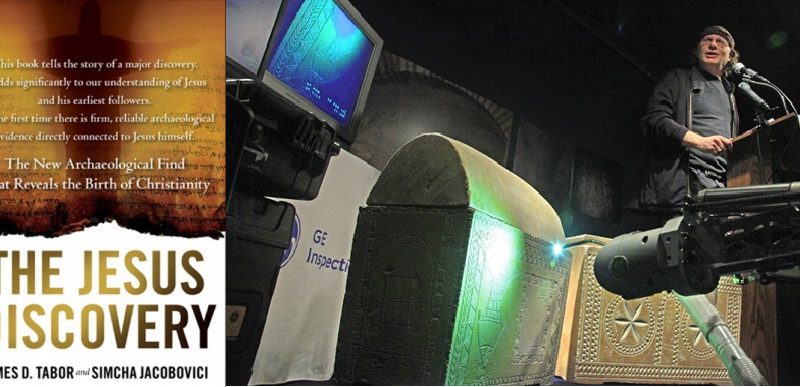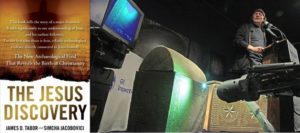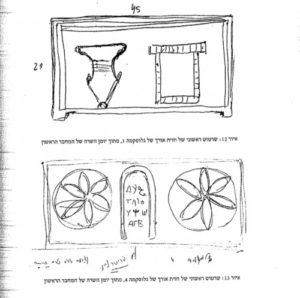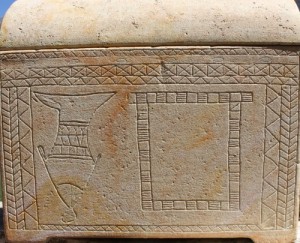THE STRANGE CASE OF DOCTOR KLONER AND MR. HYDE
This post has to do with a potential archaeological cover-up or an inexplicable case of academic incompetence. I invite readers to express their opinions and help me solve this mystery. But first some background information.
I now have in my hands the article that was published two weeks ago by Professor Amos Kloner and his former student and collaborator Professor Boaz Zissu. The article came out in conjunction with a paper delivered by Prof Kloner at a conference that took place on December 27th 2012 at Bar-Ilan University in Ramat Gan, Israel. The conference was entitled “New Studies on Jerusalem”. The article was published in a companion volume which is numbered “volume 18”. Copies of the article can be ordered at www.jerusalem-studies.com.
BACKGROUND
The article is a broadside on my film “Resurrection Tomb: The Jesus Discovery” (which can be purchased here). The film was broadcast on the Discovery Channel in the United States and on Vision TV in Canada, last spring. It is scheduled for an Israeli broadcast in 2013. Kloner’s attack was also aimed at the book I co-wrote with Professor James Tabor entitled “The Jesus Discovery: The Resurrection Tomb that Reveals the Birth of Christianity”
The film and the book report on a first century burial tomb discovered by bulldozers in 1981 in the “East Talpiot suburb of Jerusalem”. In 2010, during an Israel Antiquities Authority (IAA) licensed dig, we introduced a robotic arm outfitted with cameras into the sealed burial cave, now dubbed the “patio tomb”. The pictures that we captured made world headlines. Most dramatic was the image of a big fish spitting out a stick figure that we identified with the Biblical prophet “Jonah”. The image is scratched on the side of an ossuary (bone box). Later, our interpretation of the image was strengthened when Prof James Charlesworth (Princeton Theological Seminary) identified an inscription with the name “Jonah” scratched across the stick figure. Prof Charlesworth’s reading was corroborated by a leading Israeli epigrapher, Robert Deutsch.
The other finding that made headlines was a four-line inscription on an ossuary. It is the first inscription found on any Jerusalem ossuary declaring a statement of faith. This statement seems to be attesting to some kind of faith in resurrection.
The stakes are high. If the image is indeed a depiction of Jonah, and if the statement found close by is a statement of resurrection faith, then we may be looking at the earliest symbols of the followers of Jesus of Nazareth.
To put into context, the image of Jonah is the most popular Biblical image of early Christianity found in the catacombs of Rome. So far, one hundred and eight Jonah images have been found. Next in line in terms of popularity is the “Sacrifice of Isaac” of which only eight images have been found. Put simply, the “Sign of Jonah” is the earliest sign of the early Church. The symbol in Talpiot is at least two hundred years earlier than the images found in the catacombs. If we are right, the image of the fish was scratched by people who knew Jesus!
But more than this, the image was discovered sixty meters from another tomb – the alleged tomb of Jesus of Nazareth and some members of his family. This other tomb made headlines in 2007 when I made the film “The Lost Tomb of Jesus” and co-wrote the book (with Charles Pellegrino) “The Jesus Family Tomb” (HarperOne, 2007). In this tomb, dubbed “The Garden Tomb”, we found ossuaries with the names “Jesus son of Joseph”, “Maria” and others. Our contention was, and continues to be, that this tomb contains the mortal remains of Jesus of Nazareth. Our critics said that although there were names associated with Jesus and his family found in the “Garden Tomb”, these were common names and belonged to some other Jesus and some other Mary, not those individuals we know from the Gospels.
In this context, if the earliest signs of Christianity have now been discovered next to the alleged tomb of Jesus, the case would be closed and some of the essential tenets of Orthodox Christianity would have to be re-examined in light of the archaeology. There is a lot riding on the fish.
When the story of the new findings came out in 2010, many theologians and academics argued that the fish was not a fish and therefore could not be identified as an early symbol of the followers of Jesus. According to the critics, there is no stick figure corresponding to Jonah and there is no inscription attesting to the name Jonah. At first, the image that we call a fish was identified by Prof Steven Fine of Yeshiva University as a “Nefesh” or tower. Many rushed to agree, until Prof Joan Taylor of Kings College, London, interpreted our fish as a perfume bottle. At that point, many scholars abandoned the tower idea and subscribed to the perfume bottle hypothesis. Kloner now claims that back in 1981, he was the first to suggest that the image on the ossuary was really an amphora. But there is no record of this suggestion anywhere. In fact, it was in 2012 that Prof Antonio Lombatti first suggested the image was really an “amphora” i.e., a vase.
Despite the fact that there is no amphora scratched on any first century ossuary that looks like our fish, many academics now subscribe to the amphora theory of the fish. Into this high stakes game of New Testament archaeology enters Prof Kloner and his latest “revelations”. Let’s examine his revelations, as he calls them, and see if he is revealing or concealing.
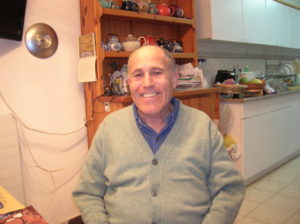
In 1981 Kloner was the Jerusalem district archaeologist for the pre-cursor of the IAA. In other words, he was responsible for the tomb in which we discovered the fish, Jonah and the resurrection inscription. But remarkably, in thirty-three years since the discovery, until now, he hasn’t published a single article on the subject. Suddenly, in light of the headlines that our findings are making, he has found his voice and published the long awaited report.
THE ARTICLE
In his article, what I found is a series of obfuscations, distortions, contradictions and what appear to be attempts to conceal rather than reveal. Let’s start with the least offensive of Kloner’s strategies and move towards the most puzzling and shocking of his published remarks.
Lets start with the proceedings themselves. The article was published as part of a volume on “new studies” on Jerusalem. What’s new about a thirty-three year old excavation? What is new is the examination that we conducted in 2010 by means of a robotic arm. But what’s new about Kloner’s excavation that took place in 1981? The answer is that here, for the first time, Kloner breaks his silence and reports on that excavation. Which leads one to the question, why was the information concealed for thirty-three years? Why did he only write his article after the broadcast of our film and the publication of our book? Even if Kloner was simply too lazy to write the article until now, why was the information not in the IAA excavation files? Why were they in some private file in Kloner’s home? Why didn’t he share the information with Rami Arav, the archaeologist who is presently in charge of the dig?
In his article, Kloner’s thesis is that Prof Tabor, Prof Arav and I are wrong about the fish and wrong about the inscription. It’s all old news with a new spin. According to Kloner the tomb is ordinary, the inscriptions are known and have been reported on and the image of the fish has been known to be a plain old amphora for a very long time. According to Kloner, its all been published before. But this is simply false.
There has not been a single article written on the 1981 dig. To try to create the impression that this is an old story, Kloner produces a 1981 article from a now defunct Israeli newspaper called “Davar” (p. 171). The article amounts to four paragraphs. It reports on the stand off with the ultra-orthodox activists who prevented the tomb from being properly explored. Kloner claims that he provided the writer, Zvi Ilan, with the information. But what does the article say about the finds? Practically nothing. No mention of an amphora, no mention of the inscriptions. Nothing. There is one telling sentence, however. It states that “the Antiquities Department wishes to investigate this unique tomb that holds within it important material that needs to be researched”. Put simply, the evidence that Kloner marshals to prove that the tomb is not important proves the exact opposite!
Kloner then tries to give the impression, through misleading footnotes, that the tomb has been the subject of an ongoing academic debate prior to our investigations. To this end, for example, when discussing the image of a temple–like structure next to the fish (p. 157, footnote 3), he quotes a private email by someone called Avraham Segol. Segol is not an academic and he wrote his email to Kloner after we published the findings in the tomb, not before. He got all of his pictures from us. Kloner also quotes an article written in 1987 on temple-like structures by the late Professor Dan Barag. The impression is that people were debating the images in the Talpiot “patio tomb” back in the 80’s. But Barag’s article has nothing to do with the tomb or the ossuaries in it. It’s about ancient Judean coins!
So far, Kloner’s approach is enough to raise eyebrows but maybe nothing more. But the story really gets strange when he provides pictures of the ossuaries, but not of the images on them! He says that he and his team took pictures of the ossuaries only in their niches (“kochim”), and not after they were pulled out and put into the open central space of the tomb. He says they didn’t take those pictures because they were under pressure from religious activists and working “speedily”. He also says that they thought they would have access to the ossuaries once they removed them from the tomb. The bottom line is that, according to Kloner, they had no time to take pictures of the ossuaries once they had been pulled out of the niches (p. 156 footnote 2). And yet, Kloner’s big revelation for his lecture and his article is the drawings he made of the images on one ossuary and the inscription on the other (p. 168). Think about it… What he’s saying is that even though he had a camera, he had no time to snap a few pictures of the “important” and “unique” (according to Davar) findings in the tomb. But with activists shouting above, no light, bones all around and the stench of millennia in the tomb, Kloner had time to draw the ossuaries and even measure them.
Can someone explain this to me? Imagine yourself in a tomb. It’s dark, it smells, and there’s hardly any air. There may even be dangerous bacteria in the tomb. Outside the tomb, above your head, activists are screaming and yelling. You have a camera around your neck but you don’t snap a photo… On the contrary, you reach into your bag, pull out a pad and a pencil and proceed to draw! Believable? I think not. We’ll get back to these drawings below.
In his article, Kloner proceeds to tell us that there were eight ossuaries in the tomb, but that he only reported seven (p. 153). I want to repeat this: Kloner admits to misreporting the findings in the tomb! He says he did this because he was afraid that if the orthodox activists knew that he had taken one ossuary out of the tomb, they would demand its reburial. Does that really make any sense? Was he really concerned that the orthodox activists were so obsessed with this particular tomb that they would ignore the other eight hundred ossuaries in the warehouse of the IAA and come looking for this one? Is this a good enough reason to purposely and repeatedly misreport the archaeological findings? More than this, when he first published the map of the tomb, he erased one of the ossuaries from the drawing! (see Kloner’s original map of the tomb in “The Jesus Discovery”, Tabor and Jacobovici p. 19). This ossuary has now popped back into Kloner’s drawing of the tomb. In other words, Kloner agrees that he played with both the ossuary count and the map when he reported on the finds. Is this responsible archaeology?
But the plot thickens. In his article, Kloner acknowledges that in the official 1994 catalogue of all ossuaries in the IAA collection, Levi Rahmani misreported that the ossuary removed by Kloner from the Talpiot tomb, came from the “Mount of Offence”, not Talpiot. He says that this misrepresentation of the provenance of the find was because Rahmani was afraid of the ultra-orthodox, the “Haredim” (p. 160). Does this make sense? Is it believable that thirteen years after the find, Rahmani was worried that the Haredim would read his obscure catalogue and hunt down the one ossuary? Is that why Rahmani misreported the place of origin of the ossuary? In any event, in his new article, Kloner admits that he misrepresented the amount of ossuaries found and altered the map of the tomb. He also admits that the location of the tomb was changed in Rahmani’s publication.
But the misreporting and contradictions don’t end there. Prior to our film and book, the only report on the tomb in an academic publication appeared in Kloner and Zissu’s book “The Necropolis of Jerusalem in the Second Temple Period” (Peters 2007, p. 342). The entire report consists of four paragraphs. No images are reported – amphora or otherwise. Kloner and Zissu write: “Greek names were inscribed on two of the ossuaries”. They don’t tell us what those names are. In 2006, when I asked Kloner about the Greek names, he said that he did not know what they were. Fearing the Haredim, he ran out of the tomb quickly and had no time to read the inscriptions. But now, suddenly, in their new article, Kloner and Zissu know exactly what the names are: “Mara” and, possibly, “Yoan” (p. 159). Isn’t this interesting, they knew about the inscriptions all along but they did not publish them until after we did (Tabor and Jacobovici p. 67-68). In fact, “Yoan” may actually be “Yona”, or Jonah. If Kloner and Zissu had these names, why didn’t they publish them until now? More than this, why did they say that there were two Greek inscriptions when they now acknowledge that they knew all along that there were three? Why do they say the inscriptions were simply “names” and they leave out the more elaborate and unique inscription that Kloner now acknowledges he had in his drawer all along? That’s a lot of things to get wrong in one little tomb. Wrong on the number of ossuaries, wrong on the location of the find, and wrong on the number of inscriptions.
There is one more blatantly bizarre thing about Kloner’s latest article. Throughout the article, he insists that they were rushed and working under great pressure. Over the years, he has repeatedly changed his story with regards to the length of time that the archaeologists were in the tomb. At first, he told one and all that he was only in there for “a few” minutes. During a conversation with me and my associate Noam Kuzar, Kloner’s fellow archaeologist, Shlomo Gudevich, said that they were in the tomb for two days! Quite a difference.
Kloner has changed his story so often that he and archaeologist Shimon Gibson have had to rewrite several times the article they’ve submitted on the subject to an upcoming publication by James Charlesworth. According to some versions of the story, Kloner left the country on a trip after the initial discovery of the tomb and was not back until after it had been sealed by the Haredim. In his revelatory new article (p. 152), Kloner pretty much admits that the tomb was found on the 15th of April 1981 and that “in the very same day” archaeologist Tsion Shabtai entered the burial tomb. The next day, on the 16th of April, a “team” arrived on the site. It was on the second day that the Haredim showed up. Even after they showed up, Kloner admits that he had an additional fifteen minutes in the tomb. He now says that he had two hours and fifteen minutes in total. Which is it? Fifteen minutes? Two hours and fifteen minutes? Or two days? His new article pretty much confirms the two-day report. They entered the tomb on the 15th of April and they were kicked out on the 16th.
In the new article, Kloner not only provides his new drawings but a detailed report on the bones in the tomb (p. 160-161). Anyone who has ever watched the TV drama CSI knows how difficult it is to examine the bones of a deceased individual. It literally takes weeks to determine the amount of individuals found in a grave. It’s a very time consuming process that has to be conducted by physical anthropologists, working in a lab. But it’s not a problem for Kloner. He doesn’t need physical anthropologists or lab conditions or even time. He can just stare into a two thousand year old bone box, filled to the brim with bones (see photo 11 p. 167) and – without removing the bones – he can simply tell how many people are buried there. As a result, he reports that in ossuary number 1, there were bones of “three individuals”; in ossuary number 2, there were the “remains of two individuals”; in ossuary number 3, “two individuals” etc. for a grand total of twenty-one to twenty-six individuals buried in the tomb. Are you following the “logic” of Kloner’s report? Put simply, Kloner says that he had no time to snap a picture but, within minutes, he was able to look into all of the ossuaries and figure out how many people were buried in them.
Kloner is blowing smoke, but why? He’s trying to go out of his way to minimize findings in a tomb that he did not report on for thirty-three years. He’s obviously had the information at his fingertips for all these decades. And now that we’ve published the material that he’s sat on for all that time, he suddenly produces pseudo bone reports to make it look like he’s a scientist and give weight to his conclusion. And what is his conclusion: “there is no connection to Judeo-Christians whatsoever” (p. 161) i.e., nothing to do with Jesus.
What does Kloner base this conclusion on? Nothing! Not a single piece of evidence, just a lot of contradictions, pseudo science and thirty-three years of no reporting or misreporting. Most dramatic are his drawings. The incredible thing about them is that they look exactly like our pictures. And that is precisely what’s wrong with them. Our photographs and the ossuary replica that we created from them (a replica that Kloner commended in front of over three hundred academics), have a flaw in them. We could not see the center of the temple-like structure to the right of the fish. Our cameras simply could not capture what’s there. We were able to tell that something’s there but we don’t know what. As a result, in our replica, we left the center of the “temple” blank. I rushed with bated breath to hear Kloner’s speech at Bar-Ilan University. I waited with anticipation to see his thirty-three year old photographs and/or drawings. What was at the center of the temple I wondered? And then Kloner said he had no pictures… but he had drawings! And, to my surprise, the drawings look like perfect copies of our replica. Blank and all!
In sum, we now have a greater mystery then we had before. We now know that the senior archaeologist responsible for the 1981 discovery of the “patio tomb” in east Talpiot, misreported the number of ossuaries found, reworked the map of the tomb that was published, went along with Rahmani when he misreported the location of the find, misreported the number of inscriptions found in the tomb, held back on the names, suppressed the discovery of the four-line inscription and has now published an unbelievable bone report… In the service of what? And what do we make of two drawings that look more like our replica than the original ossuaries? I simply have no explanation for his behavior. Maybe others can now join the investigation and put together the clues so as to reach some kind of satisfactory conclusion.
Maybe Kloner can come clean.
Comments are welcome. Unfortunately, due to a technical glitch the comments feature on this site is temporarily down but you can e-mail comments for moderated posting to: simchajtv@gmail.com
